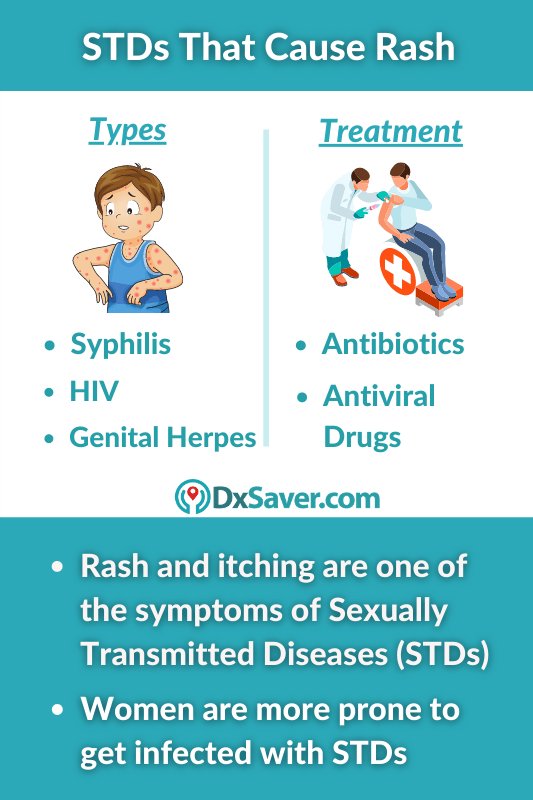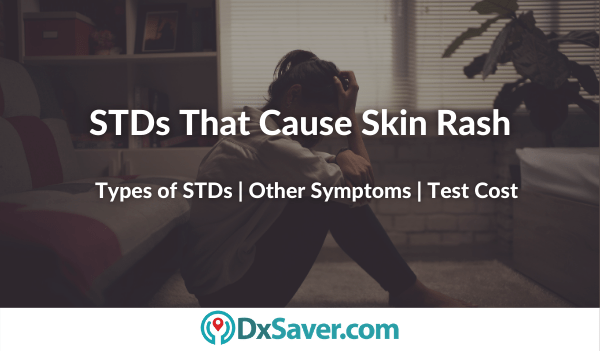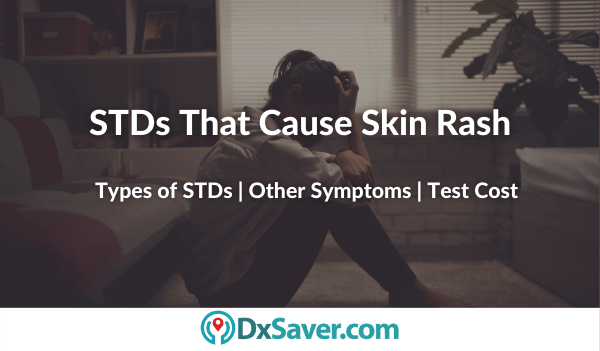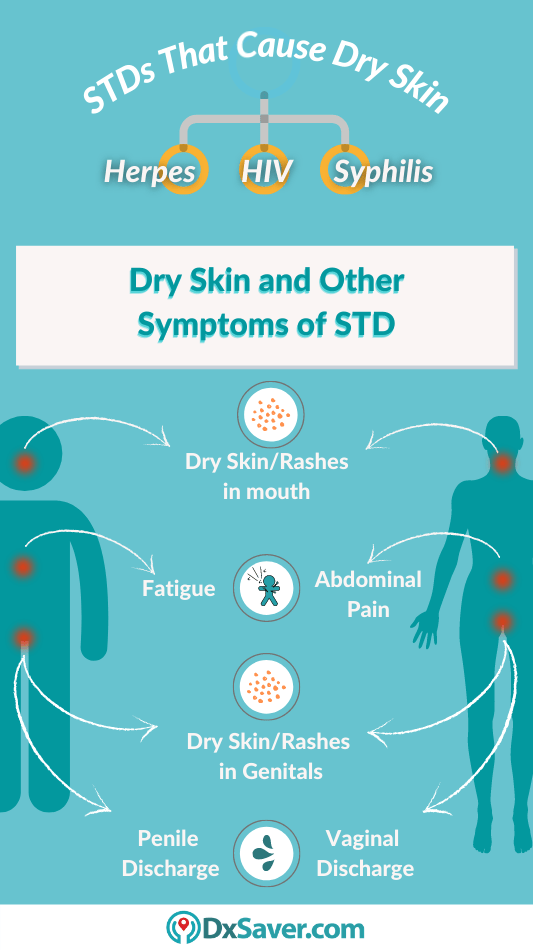Rashes on the skin and related itching can be troublesome and irritating for most people. Rashes may appear on any body part but Sexually Transmitted Diseases (STDs) related rashes, are more likely to appear around the mouth, around or on the genitals, and on the inner thighs.
STDs that are most likely to cause rashes are HIV, Syphilis and Herpes.
It is always important to know the source and the cause of the rash on your skin. People who are sexually active are at high risk of getting exposed to STDs that cause rashes. In this case, it is vital to get tested for STDs and play it safe.
In this article, we explain in detail the types of STDs that cause rashes on the body, other symptoms of STDs and how to get tested for STDs.
Do STDs Cause Skin Rash?
STDs are infections that are commonly seen in sexually active persons, particularly where safe sex isn’t practiced. According to the Center for American Progress (CAP), nearly 20 million new cases of sexually transmitted diseases are diagnosed every year in the United States. There are more than 20 different types of STDs that are caused by different bacteria, viruses, parasites, yeast, and other microorganisms that are spread from one person to another via sexual contact, i.e. vaginal, anal, and oral sex, genital touching, and exchange of body fluids.
Some STDs cause skin rash and dry skin symptoms around the genitals, mouth, and other parts of the body, appearing 2 – 3 weeks after the initial exposure. The most common STDs that have skin rashes as one of the symptoms are HIV, Herpes, and Syphilis. Generally, along with the skin rash on the body, STDs also exhibit various other symptoms in men and women. They are:
STD Symptoms in Women:
- Unusual vaginal discharge
- Painful urination
- Pain during sexual intercourse
- Lower abdominal pain
- Heavy menstrual bleeding
STD Symptoms in Men
- Thick penile discharge
- Burning sensation while urinating
- Swollen testicles
- Anal itching
- Irritation inside the penis
- Painful bowel movements
Common Symptoms of STDs in Both Men and Women
- Skin rash
- Fever
- Headache
- Weight loss
- Diarrhea
- Joint pain
- Jaundice
- Sore throat
- Dry cough
- Night sweat
- Fatigue
STD Related Rash on the inner thigh, genitals and buttocks
STDs such as genital herpes cause a rash on the groin area, particularly around the inner thigh and the genitals. Coming in contact with the genital fluids of an infected person you can easily get the infection and see symptoms like rash on thighs, genitals, and buttocks. This is due to the warm and moist nature of the inner thigh and genital area compared to any other part, as the STD-causing microorganisms prefer that environment.
Sometimes the rash is not itchy and may be confused with other skin problems and left untreated. When STD rash on the body and other symptoms are not diagnosed and detected at an early stage, then can lead to severe health complications such as infertility and cancer. Therefore, it is always a good choice to get tested and play it safe.

Book STD Packages Covering HIV, Herpes, and Syphilis
If you would like to be tested for STDs that most commonly cause rashes, we can help you choose the right provider. One of the best options for STD testing is STDcheck. The key reasons why you should choose STDcheck are given below.
- 100% Confidential STD Testing
- 5 Minute Testing with Results in 1 to 2 days
- All Tests are FDA-Approved / Cleared
- Same-Day STD Testing Available
- Over 4,500 Testing Centers Nationwide
Just click on the photo or the link given below and you can book your desired STD tests online. You can also choose a center that is nearest to your location. We recommend that you choose a 10-panel test as getting tested individually for the above three STDs that cause rashes will be more expensive than the 10-panel test package.
Detailed Information About STDS That Cause Rashes
Out of 20 different types of STDs, the STDs that cause skin rash symptoms are the following three:
Skin rash on the genitals is the most common symptom of the above STDs. Some people could also get a sore throat and oral sores (rash-like) around the mouth. This is often seen in people who had oral sex with an STD-infected person, where the infection got transmitted to the mouth and the bacteria/virus started multiplying as the wet and warm environment of the oral cavity is favorable.
STDs that Cause Skin Rash: Syphilis
Syphilis is an STD caused by bacteria called “Treponema Pallidum”. Syphilis generally affects your genitals, skin, and mucous membranes causing rashes/sores. This bacteria also has the potential to affect other parts of your body, including your heart and brain, however, this is rare.
The signs and symptoms of Syphilis are categorized into three stages, namely, primary, secondary, and tertiary. Some people do not experience any symptoms until the infection reaches the last and final stage – the tertiary stage, where the symptoms get severe. It is during the secondary stage of syphilis that skin rash on the body, especially on the genitals and mouth, starts to appear. You can get a syphilis sore if your genitals have direct contact with a syphilis sore (commonly known as a chancre). Syphilis rash typically does not itch.
Initially, a tiny, painless rash-like sore (chancre) will appear at the genitals, rectum, tongue, or lips. As the disease progresses and becomes severe, symptoms may include:
- Red or reddish-brown rash on different body parts including palms and soles
- Enlarged lymph nodes
- Fatigue
- Fever
- Soreness and aching
It is vital to get checked for Syphilis STD at an early stage, without treatment, syphilis bacteria may multiply, leading to serious internal organ damage.
Some of the signs and symptoms of tertiary-last-stage syphilis include:
- Numbness
- Paralysis
- Blindness
- Dementia
- Lack of coordination
If you are pregnant and suspect of being exposed to syphilis STD, it is of utmost importance to get treated as the condition makes it worse even for the growing fetus as there is a chance of passing the disease to the unborn infant during birth. This condition is called Congenital Syphilis – a life-threatening one.
STDs that Cause Skin Rash: Genital Herpes
Herpes infection is very common in the US. According to the latest statistics, more than one out of every six people aged 14-49 years are infected with genital herpes. Herpes is an STD caused by a virus called Herpes Simplex Virus (HSV).
Genital herpes occurs when the infection is seen in and around the genital areas, like the thigh and groin area. Women are more prone to get infected with genital herpes than men. Genital herpes can cause itching, pain, and skin rash in your genital area.
Genital herpes symptoms in men and women include skin rash on the:
- Penis
- Vulva
- Scrotum
- Anus
- Buttocks and thighs
- Urethra
Some of the other symptoms of genital herpes include:
- Vaginal discharge
- Pain and itching
- Tender, enlarged lymph nodes
- Pain when urinating
- High temperature
- Malaise (feeling unwell)
- Red blisters on the skin
- Blisters and ulcers on the external genitalia, or the cervix
There is no cure for genital herpes. However, medications can help reduce the symptoms and the risk of spreading the infection to others. While the virus stays in the body, the symptoms of the disease can subside over time especially if proper medical treatment is taken.
STDs that Cause Skin Rash: HIV
HIV is the most commonly known STD. It is caused by the Human Immunodeficiency Virus (HIV) which attacks the CD4 White Blood Cells and causes damage to the immune system. HIV symptoms appear anywhere between two weeks to a month’s time. Early symptoms of HIV include:
- Fever
- Headache
- Sore throat
- Swollen lymph glands
- Skin Rash
- Fatigue
However, people often confuse the symptoms with the common flu and often take it easy. But the virus stays low profile and keeps manipulating.
As the virus continues to multiply and destroy immune cells, you may develop mild infections or chronic signs and symptoms such as cough and shortness of breath, night sweats, prolonged fever, and more. Check out the HIV RNA early detection test here.
How Are STDs Treated?
STDs can be treated if they are detected at an early stage. Treatment for STDs can be categorized into two groups based on the type of STD you are affected with – the treatment includes:
- Antibiotics: Antibiotics come in pills prescribed by your physician if you are affected with STDs that are caused by bacteria. STDs caused by bacteria include gonorrhea, syphilis, chlamydia, and trichomoniasis. Typically, you’ll be advised to abstain from sex until seven days after you’ve completed antibiotic treatment and any sores have healed. It is also advisable for women to take rest for three months because there is a high chance of reinfection.
- Antiviral Drugs: In the case of herpes or HIV, which are STDs caused by viruses, you will be prescribed an antiviral drug. Herpes and HIV cannot be cured completely, but they can be controlled and the symptoms can be reduced by taking antiviral drugs. This can help in keeping the STDs in check for many years. The sooner you start treatment, the more effective it is.
How Much Does STD Testing Cost?
There are many providers of STD testing in the market each with its own merits. Our partner company, STDcheck distinguishes itself due to its vast network, 5 minutes testing process, and certified testing. The STD testing starts at just $24 but taking a panel of tests is usually more economical where you can get tested for as many as 10 STDs for under $150
STDcheck Network / Lab Locations Across the US
STD tests can be done across the US in any of the states. STDCheck has over 4500 labs each so you will never be too far away from an STD testing lab.
FAQs About STDcheck
Will insurance cover my STD testing cost?
In order to ensure your privacy, STDcheck does not accept insurance. However, you can be provided with an itemized receipt for insurance reimbursement purposes.
How should I book my appointment for STD testing?
Using the above-given links, you can go to the STDcheck website, choose your tests, and your location, and book the tests or panels online. The whole process is easy and straightforward.
Can I cancel my lab test order?
You may cancel your order at any time before you visit the lab. A 20% cancellation fee will be charged for refunds. All cancellation requests made 21 days after purchase will be given credit for future testing.
Do the providers offer result interpretations?
If your results are positive, STDcheck can provide a doctor consultation and a written prescription for $95. STDcheck offers a written prescription for your partner at an additional fee of $95.
How do I receive my report?
You can view the results through the online portal.










